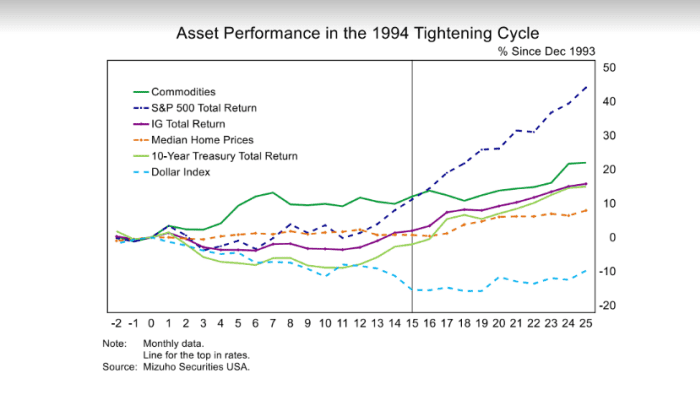This post was originally published on this site
With recession fears gripping markets as the Federal Reserve pulls back its easy-money stance to fight high inflation, investors have had few places in 2022 to hide from carnage in financial markets.
But what if the Fed Chairman Jerome Powell succeeds in his “softish” landing, like the central bank’s rare 1994-’95 tightening cycle that didn’t knock the economy into the dumps?
Mizuho Securities economists looked at which assets performed best through that cycle. They found stocks and commodities
CL00,
GC00,
produced the highest returns of roughly 12% and 11%, respectively, as rates peaked (see chart, gray line), followed by investment-grade corporate bonds,
LQD,
as the Fed doubled its policy rate to about 6%, or 600 basis points.

What worked in the ‘model’ 1994-1995 Fed tightening cycle.
Mizuho Securities
“The Fed started hiking rates in February 1994 from 300 bps to 600 bps in February 1995,” said Mizuho Securities’ Alex Pelle and Steven Ricchiuto, in a Thursday note. “No recession resulted, and this is held out by various hawkish policymakers as a model tightening cycle.”
The dollar
DXY,
ended the cycle down more than 15%, as measured against a basket of rival currencies, while the S&P 500 index
SPX,
and several other asset classes found a bottom “mid-tightening cycle.” Of note, home prices stayed roughly flat.
“Of course, there are major economic and valuation differences between today and 1994,” the team wrote, adding that a “soft landing” isn’t their baseline economic scenario for the current tightening cycle.
This year, it’s been sharp losses for stocks, even outside of the high-flying technology companies that earlier lifted equity indexes to pandemic records. Highly rated corporate bonds also haven’t had it this rough since the collapse of Lehman Brothers.
There’s also the effects of a fading mania in newer financial sectors, including cryptocurrencies
BTCUSD,
and “blank-check,” or special-purpose acquisition companies (SPACs). That’s resulted in shocking losses for some investors, even before the Fed has yet to significantly raise its policy rate or begun to shrink its nearly $9 trillion balance sheet in this cycle.

